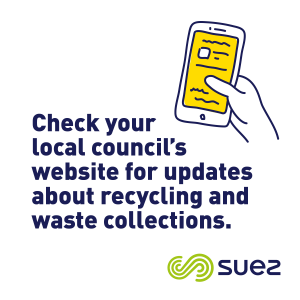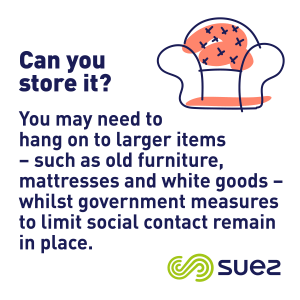Collections during a national crisis | key issues faced by local authorities during the COVID-19 pandemic
9th April 2020
The circumstances surrounding the COVID-19 pandemic are unlike anything we’ve seen before. We’re having to react to a rapidly evolving environment while ensuring that we are following government and Public Health England’s guidelines to minimise the risk of spreading coronavirus. With no real examples of what’s been done before to draw upon, these challenging times present many questions for those dealing with waste management here in the UK. On 01 and 02 April 2020, Dr Adam Read, External Affairs Director at SUEZ recycling and recovery UK, hosted two webinars for our customers, including representatives from the industry and local authorities. They explored the challenges faced and the measures which have been put in place by collection and disposal authorities to limit the spread of the virus, whilst keeping critical services operational. We summarised panel discussions with Lee Richardson of Doncaster, Trevor Nicoll of Greater Cambridge and CIWM, Jarno Stet of NAWDO, Kristy Spindler of South Gloucestershire and Ian Fielding of North Yorkshire and ADEPT. Hopefully this blog post will provide a bit more clarity and some food for thought.
Staffing

The key issue for many local authorities right now is the reduction in their staffing levels as people who are poorly or vulnerable remove themselves from society for varying periods of isolation. There are reports of some of the affected team members now starting to return to work, however staffing levels are down to 60% in some locations and this is significantly impacting service provision. With the closure of many industrial, business and commercial outlets, some operational collection teams are able to be redeployed on front line municipal recycling and residual waste collections. Furthermore, staff from other council services is being used to support current front-line services, even working across boundaries. There is undoubtedly a heightened sense of togetherness being demonstrated across the country, as public and private sector teams support each other during these testing times.
Closure of HWRCs
Our decision to close all household waste and recycling centres, is not only in line with current government policy, but presents an opportunity to redeploy staff to front line collection services. This is consistent with messages from a number of local authority surveys published in recent days*. In addition, these sites could provide valuable additional storage capacity for some materials, should changes in the existing supply chain result in some materials not being processed and provided to end markets at the usual rate.
While frustrating for many householders, particularly with Easter holidays upon us (naturally a time for spring cleaning or a bit of DIY) many residents are supportive of this decision and stand united with government advice. Local authorities and their service providers welcome this increased level of positive public engagement and see it as a unique opportunity to share key messages about the correct presentation of materials and how to avoid putting additional pressure on the collection service whilst we are in uncharted waters.
Collection streams
While all authorities continue to collect general waste, many have had to reduce the streams they are collecting, for example, withdrawing or experiencing significant disruption to green waste collections*. In some cases, they are asking for householders to present their wastes in the same segregated manner that they are used to, ensuring behaviours are maintained, even if some of that material is ending up mixed for treatment and disposal. However, many councils are choosing to remove garden and bulky wastes first, once staffing issues become particularly acute.

It is key at this time, and for the remainder of the crisis, to convey a clear message to residents. In order to maintain a good waste collection service, society must avoid creating additional waste in the first place. Many local authorities, along with the likes of WRAP and the CIWM, are already promoting key messages that this is not the time to have a clear out, spring clean, or to start any DIY projects. This is to remind everyone that we are at home for our own and others’ protection. However, some authorities are starting to see an increase in side-waste, whilst the litter bins are showing a trend with high volume locations changing from town centre to more rural locations as people seek green spaces for daily exercise.
Supply chain
As we continue to see increases in residual waste generated by households, and a reduction in commercial waste, there are unanswered questions concerning how this will impact the material flow to treatment plants, and the suitability of the materials for these sites. There seems to be little we can do at this moment, though we can continue to monitor changes in moisture, calorific value and composition to help predict if changes in feedstocks will become a bigger concern, which might not take effect until after the pandemic ends.
Social distancing
While our teams have key worker status and are integral to the continued operations of this country, we must do everything we can to minimise the risk to our front line workers, and this includes enforcing the two-metre social distancing rule. Many local authorities have moved to a ‘driver plus one’ model which minimises any contact within the cab to a safe distance, and spreads the usual workforce across more routes, thereby serving more of the public. For some local authorities who do not have access to spare vehicles, having staff follow the trucks in pool cars has been explored, but this has not been generally adopted due to health and safety concerns.
PPE
Along with the usual high-vis, boots and gloves, teams are being provided with hand sanitisers to ensure that they can minimise the risks they are exposed to. There are rumours of the additional measures such as face masks being brought in for key workers, but the evidence suggests they are ineffective for waste collection staff and that they may encourage face touching – something which should be avoided at this time. The recently released WISH guidance is easy to adopt and is the best current guidance in the sector. However, a key concern is how to get essential PPE to the right places. It may be that the government should control this supply more as pricing is up to 10 times the normal cost for essential items.
Next steps
There is a renewed respect for business continuity plans at this time, and revisions to these are being made now they have been thoroughly tested. Beyond this, there are many whose thoughts are already stretching to the future issues that we may face, including potential increases in fly tipping while HWRCs are closed, and how safely we can reopen and reinstate services both effectively and efficiently. With this in mind, perhaps some sites could become single material stream for a period of time or develop new operating procedures to ensure social distancing. Realistically, we need to pause at this point. We now look to the ESA, CIWM, WISH and DEFRA for more clarity over storage of waste for 72-hours at home, supplying PPE to front line teams, guidance on service prioritisation, and for new protocols when considering how HWRCs might operate once the government relents on travel restrictions.
We all wait with interest, and we will all continue to depend on the government to help share best practice, industry concerns, and sector updates.
* All references taken from responses to SUEZ recycling and recovery survey of local authority customers as of 04 April 2020.
Tweet
